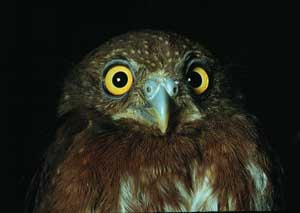|
|
 38 predator eyes - owl DHJanzen100202.jpg high resolution
|
|
|
My take on false eyes? If you are a small bird foraging through the understory of a tropical (or temperate) forest, and you come around the corner among the shady and poorly illuminated forest foliage, and find an eye in your field of vision, what do you do? If you stop to take a millisecond to evaluate whether it is truly an eye, or a false eye, or even an eye of no one of consequence, you are lunch. Your reaction to an eye - any sort of eye - should be instant flight. It should be a reflex. Not necessarily very far, but to back off, fast. And in the foliage, this means that very likely the insect - or predator - is again out of sight. Are you going to go back in there looking to see if it was a luscious insect or a snake, hawk, owl, cat, lizard, dog, primate, etc.? No. The potential prey insect has escaped and selection has acted, favoring that eye spot color pattern. This is a Costa Rican least pigmy owl (Glaucidium minutissimum) about the size of a ordinary saltshaker and highly insectivorous. |
||
back to lecture slides
or skip to: